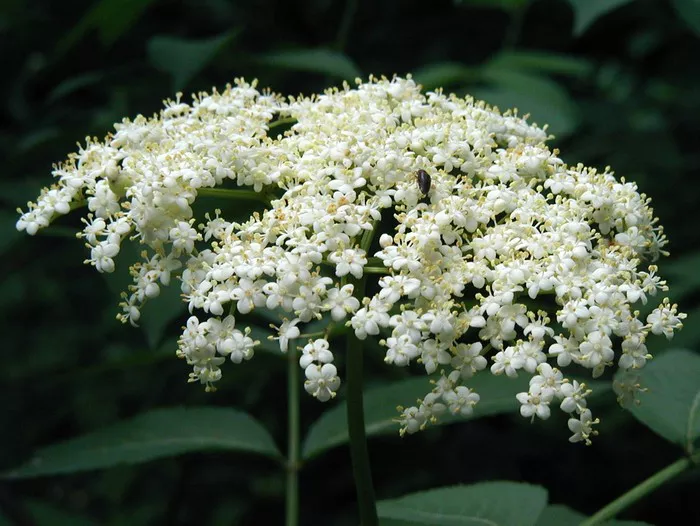Elderberry flowers, borne by the Sambucus genus of flowering plants, are not only visually striking but also hold significant cultural, culinary, and medicinal value. Understanding their appearance is crucial for botanical enthusiasts, foragers, herbalists, and gardeners alike. In this comprehensive guide, we delve into the intricate details of elderberry flowers, providing specific descriptions and insights into their morphology, color variations, growth patterns, and ecological significance.
Elderberry Flowers
Elderberry flowers are the blossoms of the elder tree, scientifically known as Sambucus. These deciduous shrubs or small trees belong to the Adoxaceae family and are native to Europe, Africa, and parts of Asia and North America. The most common species include Sambucus nigra (European elder) and Sambucus canadensis (American elder). While elderberries are prized for their edible fruits, elderflower, the blossom of the elder tree, also holds culinary and medicinal importance.
Morphology of Elderberry Flowers
Elderberry flowers exhibit a distinctive morphology, characterized by a cluster of tiny, creamy-white to off-white blossoms arranged in a large, flat-topped inflorescence known as a corymb. Each corymb consists of numerous individual flowers, typically ranging from 5 to 12 millimeters in diameter.
Color Variations
The color of elderberry flowers can vary slightly depending on the species and environmental conditions. Generally, elderflower blooms are creamy-white to off-white, with a delicate, sweet fragrance. However, subtle variations in hue, ranging from pale yellow to ivory, may occur. These variations add to the aesthetic appeal of elderberry flowers, making them a charming addition to any landscape.
Physical Characteristics
Elderberry flowers possess several distinguishing physical characteristics that aid in their identification:
Petals: Each elderflower consists of five tiny petals arranged in a radial pattern, giving the blossom a star-like appearance. These petals are often reflexed slightly backward, creating an open, inviting structure.
Stamens: Surrounding the central stigma, numerous stamens with yellow anthers extend outward from the flower’s center. These stamens are responsible for producing pollen, essential for the flower’s reproductive process.
Stigma: At the center of the flower lies the stigma, a protruding structure designed to capture pollen during pollination. The stigma is typically greenish-white or pale yellow in color.
Inflorescence: Elderberry flowers are borne in large, flat-topped clusters known as corymbs. Each corymb consists of multiple individual flowers arranged in a radial pattern, creating a visually striking display.
Growth Patterns and Habitat
Elderberry plants are typically found in a variety of habitats, including woodland edges, hedgerows, stream banks, and disturbed areas. They are adaptable to a wide range of soil types, preferring moist, well-drained soils with adequate sunlight. Elderberry flowers bloom in late spring to early summer, typically from May to June in the northern hemisphere, although exact timing may vary depending on geographic location and climate conditions.
Ecological Significance
Elderberry flowers play a vital role in supporting local ecosystems and wildlife. They serve as a valuable source of nectar for pollinators such as bees, butterflies, and moths, contributing to the health and diversity of native insect populations. Additionally, elderberries are an important food source for birds and small mammals, providing nourishment during the late summer and early fall months when fruits ripen.
Culinary and Medicinal Uses
In addition to their ecological significance, elderberry flowers hold cultural and culinary importance in many societies. They are commonly used in traditional European cuisine to flavor beverages, desserts, and preserves. Elderflower cordial, made by steeping elderflower blossoms in a sugar syrup, is a popular summertime refreshment enjoyed across the continent.
Furthermore, elderflower has a long history of medicinal use in folk medicine traditions. It is believed to possess anti-inflammatory, antiviral, and immune-boosting properties, making it a common ingredient in herbal remedies for colds, flu, and respiratory ailments. Elderflower tea, tinctures, and syrups are often used to alleviate symptoms and promote overall wellness.
Cultivation and Harvesting
For those interested in cultivating elderberry plants for their flowers and fruits, proper care and maintenance are essential. Elderberries are relatively low-maintenance once established and can thrive in a variety of growing conditions. They prefer full sun to partial shade and well-drained soil with moderate moisture levels.
Elderberry plants can be propagated from seeds, cuttings, or suckers, with cuttings being the preferred method for maintaining desirable traits. When harvesting elderflowers for culinary or medicinal use, it’s essential to gather them at the peak of freshness, typically when the blossoms are fully open and fragrant. Care should be taken to avoid collecting flowers that have been exposed to pesticides or other contaminants.
Conclusion
In conclusion, elderberry flowers are not only visually captivating but also hold significant cultural, culinary, and medicinal value. Their distinctive morphology, color variations, and ecological significance make them a fascinating subject for botanical enthusiasts and a cherished ingredient in cuisines and herbal traditions around the world. By understanding the unique characteristics of elderberry flowers and their role in the natural environment, we can better appreciate and cultivate these remarkable plants for generations to come.


